Don’t light that Yule Log just yet

If it seems like we’ve had a lot of Spare-the-Air days recently in the Bay Area, you’re right. Wednesday will bring the total to eight air quality alerts since November 1st, when the season began.
Blame the weather. Last year there were only four all season, November-February, mostly because it was so rainy. The Bay Area Air Quality Management District, the agency responsible for issuing the alerts, has recorded up to 20 in a single winter. So eight in a month and a half is pretty significant, though it’s hard to know if the trend will continue since weather patterns change constantly.
In summer, alerts are caused mostly by tailpipe emissions that rise into the atmosphere and are heated by the sun, turning into brown smog. That’s hazardous to people’s health, not to mention smudging that vista from the back porch. For summer alerts, officials ask residents to reduce the amount they drive.
In the winter, the concerns are different. Air quality regulators worry about particulate matter, like soot, getting trapped close to the earth where people breathe it in hazardous quantities.
“It’s sort of like you lowered the ceiling down and now those pollutants are accumulating and concentrating in a much shallower space, a space where we breathe,” Ralph Borrmann, a spokesman for the Bay Area Air Quality Management District, told me. “And it can quickly build up to unhealthy levels.”
Winter Spare-the-Air days are often declared on cold, clear nights because of a process called inversion. Overnight the earth radiates heat, cooling both the ground and the layer of air closest to earth’s surface. That leaves a warmer band of air above that traps pollutants. In the winter, wood-burning is a big air polluter, making up 30% of air pollution.
[module align=”right” width=”half” type=”pull-quote”]”It’s sort of like you lowered the ceiling down and now those pollutants are accumulating and concentrating in a much shallower space, a space where we breathe.”[/module]
“We get a lot of people who call or email because, frankly, they are unhappy that they can’t burn as they would like to burn on certain days,” said Borrmann. “But keep in mind there are only a handful of days throughout the year and any other time when air quality is OK you’re free to burn.”
Borrmann didn’t appear to have much sympathy for the complainers and he noted that because it’s a no burn rule, violators can be ticketed to the tune of $400. Everyone gets a warning first, but after that there can be consequences. I asked Borrmann what the Air District does when someone needs to heat their home with wood. He told me that instance is rare in the Bay Area. Most people have an alternate form of heat and they are required to use it on Spare-the-Air days — no matter how much they dread that PG&E bill.
One thought on “Soot in Your Stocking: A Spate of Spare-the-Air Days in the Bay Area”
Comments are closed.


If people who love the efficiency, the common sense logic for using sustainable, renewable wood fuel combustion for heat and find these short sited, poorly conducted – energy agenda manipulated studies, that determine that the typical log wood they use is POISON enough for your increase in electricity spending, then you need to look at the reality that fixes the smoke issues from your wood heaters. It is not a new appliance and it is not necessary to switch to an alternative fuel. After correct use of the appliance itself; seasoned wood, air intake control etc., you need to make sure negative atmospheric is not affecting the combustion from above the flue. The HPBA, the air authorities don’t teach this because they are using the scheme for investment purposes. There are cowls out there that do a lot more than just protect the chimney from animals, rain and snow. By reversing the negative effects that winter weather brings, i.e. these cold inversion days, many in the know have already witnessed that visible emissions can become non existant in less than 2 minutes. Engineers are doing brilliant things all the time and so are corrupt practices around the green market economy. Be vigilant and embrace the real fixes out there. It’s smoke they want stopped – not self sufficiency and energy conservation – right?